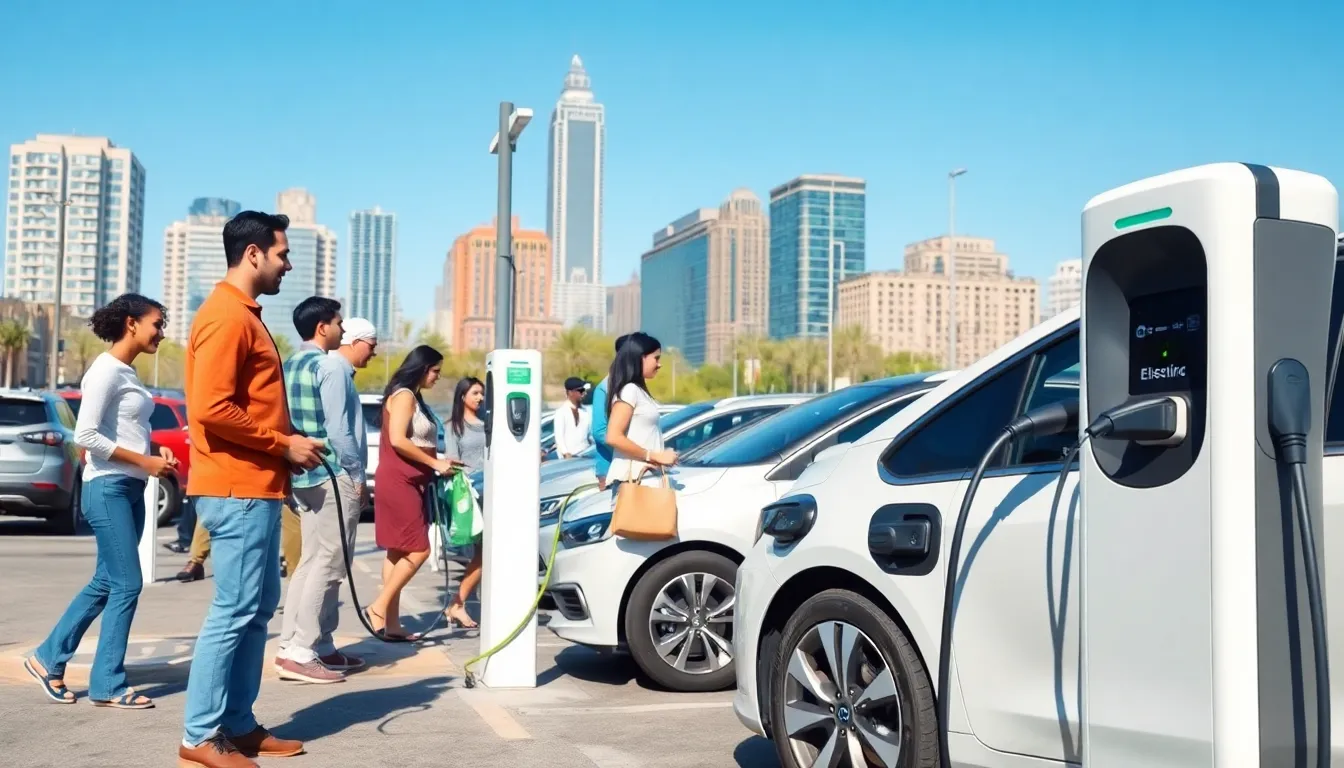As electric vehicles hit the roads in droves, the need for reliable charging networks has never been more critical. Imagine cruising down the highway, only to find yourself in a charging desert, praying for a miracle—or at least a friendly gas station attendant. With the right charging infrastructure, those fears vanish faster than the last slice of pizza at a party.
EV charging networks are transforming the way we think about refueling. No longer do drivers need to rely solely on gas stations; they can now plug in and power up at an array of locations. From shopping malls to roadside diners, the options are expanding faster than your favorite streaming service’s library. Join the revolution and discover how these networks are paving the way for a cleaner, greener future—one charge at a time.
Table of Contents
ToggleOverview of EV Charging Networks
EV charging networks play a critical role in supporting the growth of electric vehicles. These networks comprise a variety of charging stations accessible to drivers, allowing for convenient EV usage and reducing anxiety related to battery depletion.
Definition of EV Charging Networks
EV charging networks consist of interconnected charging stations that provide power to electric vehicles. Various types of chargers exist within these networks, including Level 1, Level 2, and DC fast chargers. Station locations may vary, with options found at public places like shopping centers, parking garages, and highway rest areas. By offering reliable access to charging facilities, these networks ensure EV owners can maintain their vehicles efficiently.
Importance of EV Charging Infrastructure
EV charging infrastructure is essential for the widespread adoption of electric vehicles. A robust network fosters confidence among potential EV buyers by minimizing range anxiety, the fear of running out of power without access to a charger. Increased infrastructure supports long-distance travel and daily commutes, making EV ownership more appealing. Furthermore, integrating charging stations into urban and rural settings promotes sustainable transportation options. As governments and private stakeholders invest in expanding this infrastructure, cleaner environments and reduced carbon emissions will result, advancing the transition to greener mobility solutions.
Types of Charging Stations

Charging stations play a vital role in the expansion of EV infrastructure. Three main types of charging stations exist: Level 1, Level 2, and DC fast chargers.
Level 1 Charging
Level 1 charging offers the most basic solution for EV owners. It utilizes standard household outlets, typically providing 120 volts. Charging an EV with a Level 1 station may take up to 12 hours for a full charge, making it suitable for overnight charging at home. Many drivers find these stations convenient for residential use, as they don’t require special installations. This type of charging often appeals to those who drive short distances daily and can recharge every night.
Level 2 Charging
Level 2 charging stations deliver a faster charging option than Level 1. Operating at 240 volts, these stations can provide a full charge in about 4 to 6 hours. Many commercial locations, such as shopping centers and workplaces, have installed Level 2 chargers to accommodate drivers. Using a Level 2 station allows for more flexibility, enabling EV owners to take longer trips without significant downtime. Such connectivity enhances the urban charging landscape significantly, as they are often strategically placed in high-traffic areas.
DC Fast Charging
DC fast charging represents the most efficient method for charging EVs. Capable of delivering 400 volts or more, these chargers can provide approximately 80% battery capacity in 30 minutes or less. Locations featuring DC fast chargers are typically found along major highways, facilitating long-distance travel. Utilizing rapid charging technology, these stations cater to drivers in need of quick refueling during their journeys. Overall, DC fast charging helps decrease range anxiety significantly, ensuring that drivers can travel farther without prolonged waiting times.
Key Players in EV Charging Networks
The landscape of EV charging networks includes various essential participants. These players optimize access and convenience for electric vehicle users.
Public Charging Networks
Public charging networks consist of widely accessible stations. Companies like ChargePoint, EVgo, and Blink operate these facilities, enabling easy charging in urban and suburban areas. Locations such as shopping malls, parks, and office complexes frequently host these stations. These networks support multiple charging types, including Level 2 and DC fast charging options. Access to numerous charging stations reduces range anxiety and encourages more drivers to transition to electric vehicles. As investment in public chargers continues, the availability improves, benefitting all EV drivers.
Private Charging Solutions
Private charging solutions focus on individual users and organizations. Home charging stations play a critical role, with many EV owners installing Level 2 chargers in garages. Companies like Tesla offer exclusive charging infrastructure, such as Supercharger stations, enhancing convenience for their customers. Fleet operators increasingly adopt private solutions to charge multiple vehicles efficiently. Businesses also explore workplace charging options. These strategies help streamline operations and ensure vehicles remain charged for daily activities.
Government and Utility Involvement
Government and utility involvement significantly impacts EV charging networks. Federal and state initiatives provide funding for infrastructure development. Programs like the Electrify America initiative aim to expand charging networks across the country. Utilities also contribute through incentives and rebate programs, supporting both public and private charging installations. By collaborating with private companies, they foster comprehensive solutions. These partnerships facilitate the necessary expansion and sustainability of EV charging infrastructure, promoting a cleaner future.
Current Challenges in EV Charging Networks
The development of EV charging networks faces several challenges that impact their growth and usability.
Accessibility Issues
Accessibility remains a major hurdle for many EV drivers. Some charging stations might be located far from residential areas, particularly in rural regions. Urban drivers often encounter crowded charging stations, leading to longer wait times. Installing more stations in convenient locations could enhance user experience. Additionally, some installations lack adequate signage, making them hard to locate. Efforts to improve the visibility and availability of charging stations can alleviate these issues.
Charging Speed and Efficiency
Charging speed significantly affects the overall user experience with EVs. Many Level 2 chargers take 4 to 6 hours to fully charge a vehicle, which may not fit into the schedules of busy drivers. In contrast, DC fast chargers provide rapid charging, but their availability is still limited. Users often find that charging at public stations can be less efficient due to varying levels of power output. Addressing these speed and efficiency concerns is crucial for encouraging more drivers to adopt electric vehicles.
Standardization and Compatibility
Standardization in charging technology presents challenges for EV users. Different manufacturers may employ various charging connectors, resulting in compatibility issues. Drivers often find themselves unsure of which connector fits their vehicle, creating confusion at charging stations. Adopting universal charging standards could simplify the charging process and enhance user satisfaction. Manufacturers and network operators must collaborate to create streamlined solutions for all EVs, promoting a more cohesive charging experience.
Future Trends in EV Charging Networks
Electric vehicle charging networks are evolving rapidly, reflecting advancements in technology and infrastructure. These trends are pivotal for enhancing the user experience and supporting the increasing demand for electric vehicles.
Expansion of Charging Stations
Expansion of charging stations continues to occur across urban and rural landscapes. Cities are adding more public charging locations in parking areas, shopping centers, and transportation hubs. Rural regions also benefit from new installations along roadways and in community centers. Initiatives, such as government funding and incentives, drive the development of these networks. According to the U.S. Department of Energy, there are currently about 130,000 public charging stations in the U.S., and this number is expected to increase significantly in the coming years.
Technological Innovations
Technological innovations are redefining the landscape of EV charging. Smart chargers equipped with advanced features such as app connectivity allow users to monitor charging remotely. Additionally, many stations now utilize renewable energy sources, enhancing sustainability. Battery technology is also improving, leading to faster charging times and increased energy efficiency. As innovations continue to emerge, their ability to meet the diverse needs of EV drivers becomes more promising.
Integration with Smart Grids
Integration with smart grids offers numerous advantages for EV charging networks. Intelligent systems can manage electricity demand efficiently, minimizing peak load issues. Charging stations connected to smart grids facilitate dynamic pricing, encouraging off-peak charging habits. Integration supports more significant renewable energy contributions, further driving sustainability in transportation networks. Through this collaboration, EV charging infrastructure can promote an optimized energy ecosystem.
The evolution of EV charging networks marks a significant step toward a sustainable future. As more charging stations emerge across various locations drivers can enjoy greater convenience and confidence in their electric vehicles. The collaboration between public and private sectors is essential for overcoming current challenges and enhancing accessibility.
With ongoing advancements in technology and infrastructure the landscape of EV charging will continue to improve. This transformation not only supports the growing demand for electric vehicles but also contributes to a cleaner environment. As the charging network expands it paves the way for a greener and more efficient transportation system that benefits everyone.





